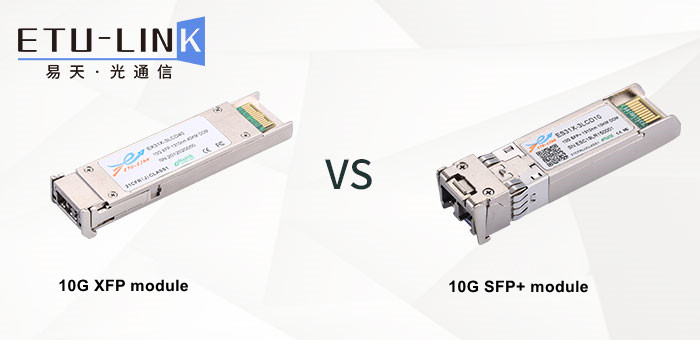
What is the difference between XFP and SFP+ optical modules? Can they be connected to each other?
In optical fiber networks, 10G optical modules are widely used in schools, companies and other application environments due to their low cost and power consumption. XFP and SFP+ are two common package types of 10G optical modules. ETU-LINK will introduce the difference between XFP and SFP+ optical modules. And can they both be connected to each other?
What is XFP optical modules?
XFP is the package of 10G optical module, which is a standardized package of serial 10G optical transceiver module. The 10 Gigabit XFP optical module is a hot-swappable I/O device that is inserted into a 10 Gigabit port. The electrical interface of the motherboard is a standardized 10G serial interface called XFI. It is compliant with 10G Fibre Channel, 10G Ethernet, SONET/OC-192 and SDH/STM-64 standards. The XFP optical module can support a transmission distance of up to 100 kilometers.
What is SFP+ Optical Modules?
The SFP+ optical module is an optical module with a transmission rate of 10G. The package type is SFP+. This optical module has significant advantages such as high density, low power consumption, and lower system construction costs. It has a wide range of applications in optical transmission network, WDM wavelength division multiplexing system engineering, single fiber bidirectional system engineering and so on. The transmission distance of SFP+ optical module multi-mode optical module is 300 meters, while the single-mode optical module can transmit up to 100 kilometers.
What are the differences between XFP and SFP+ optical modules?
1. Different appearance, and SFP+ is smaller than XFP

2. The functions are different. Compared with SFP+ optical modules, XFP optical modules have signal modulation function, serial/deserializer, MAC, clock and data recovery (CDR), and electronic dispersion compensation (EDC) functions. Therefore, when the above functions are not integrated on the mainboard of the switch router, the XFP optical module is needed to make up for it.
3. The compliant protocols are different. XFP complies with the XFP MSA protocol, while SFP+ complies with the IEEE 802.3ae, SFF-8431, and SFF-8432 protocols.
Can they be connected to each other?
As long as the transmission rate, transmission distance, and wavelength are consistent, they can be connected to each other with optical fibers. For example, a 10G XFP optical module with a wavelength of 1310nm and a transmission distance of 10KM can be connected to a 10G SFP+ optical module with a wavelength of 1310nm and a transmission distance of 10KM. Although the transmission rate of optical modules in the market has risen to 200G, this does not mean that 10G optical modules will withdraw from the market. At present, 10G optical modules are still the mainstream. 10G XFP optical modules and 10G SFP+ optical modules are irreplaceable because of differences in size, structure, compatibility, etc.
Categories
New Blog
Tags
© Copyright: 2025 ETU-Link Technology CO ., LTD All Rights Reserved.

IPv6 network supported
Friendly Links:
易天官网